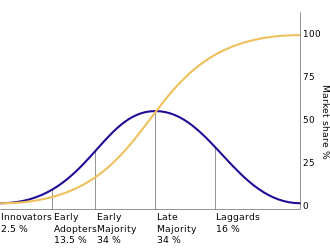So who are the people sectioned off at the bottom of the graph? Innovators are the ones who create the object or concept in question. The early adopters are the first ones to actually apply the object or concept. The early majority is much the same, but at a larger rate due to the early adopters having already used what's in question for a long enough time. The late majority follows the early majority, except it's lagging behind a little bit. A "little bit" is a few years, unlike the last group of laggards, who are much later or farther behind. Laggards are the latest among the population to use the object or concept, using it many years after the majority has already taken up what's being diffused/spread out.
How to Understand it in History: the Printing Press
Take the printing press for example. The established inventor, Johannes Gutenberg, from Germany, was one of the people to come up with the idea of the first Western style of printing, as well as the only one to actually have built prototypes of what would become the famed Gutenberg printing press in 1440, later being perfected in 1450 and put to commercial use.
What good did that do him... Gutenberg, the inventor, died penniless and uncredited for decades. However, he was who would be one of the "innovators."
The "early adopters" would be the commercial printers that printed over 8 million books in Europe by the end of the century. It was a convenient invention for publishing companies and their copy-writers, churning out more books that were produced practically identically quicker than an office full of copy-writers.
The "early majority" were rather different than the early adopters. The early adopters and those that bought from them had higher education and, with it, literacy. As there were more books being produced and educational institutions popping up due to a humble German invention, there was a slowly increasing literacy among poorer classes of late 15th-early 16th Century Europeans who were dependent on their churches. The Catholic Church at the time was not happy.
The Church was maintained on the backs of illiterate, ill-educated (if at all), low-wage peasants who were willing to pay for spiritual redemption and listen to some form of the Holy Bible that a (possibly) also illiterate priest memorized through oral telling from a higher-level religious member. Within the Church, there were holy members who were growing aware of Church violations or moralities that did not align with what they understood as "holy" or in line with the Bible. One example of an angered religious man was Martin Luther, father of Lutheranism.
Martin Luther and other "radicals" during the 16th Century were among the tipping point population, those that are in the transition between early and late majority. The "late majority" are in the Enlightenment.
In the Enlightenment picture above, you can see men arguing with a clergy member. More of the men in the image are turned to or gesturing to the non-clergy man standing above the clergyman, seeming to be reading from a thick book. The clergy had lost a significant influence of its spiritual and even political influence in the countries they were posted in, especially France.
Enlightenment thinkers like Voltaire, Jean-Jacques Rousseau, and Montesquieu were part of the "late majority," capitalizing on the evolved printing press with political, religious, moral and other ideas in books that exploded throughout Europe and the known world. Granted, there may have been extremists on ideas, possibly even fights and wars breaking out (ex. the American, French, and Haitian Revolutions).
Enlightenment thinkers like Voltaire, Jean-Jacques Rousseau, and Montesquieu were part of the "late majority," capitalizing on the evolved printing press with political, religious, moral and other ideas in books that exploded throughout Europe and the known world. Granted, there may have been extremists on ideas, possibly even fights and wars breaking out (ex. the American, French, and Haitian Revolutions).
People who would be considered "laggards" were likely unable to read, unwilling to read, or in a place where reading wasn't too important or necessary.
People may be late to, or never will, adopt new technologies, due to unsureness about the technology or because they feel they are able to continue comfortably without the technology in question. There's also people who may not be educated enough to adopt the technology, just like the lower classes of Gutenberg's time until the Enlightenment. They weren't able to read well if at all. Why waste time or money on something you are unable to use or appreciate? This question may be why people are noticeably late to adopt technologies, if they do at all.
/cdn.vox-cdn.com/uploads/chorus_image/image/69632702/cwelch_191031_3763_0001.0.jpg)



No comments:
Post a Comment